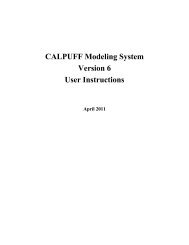Volume 1 - The Atmospheric Studies Group at TRC
Volume 1 - The Atmospheric Studies Group at TRC
Volume 1 - The Atmospheric Studies Group at TRC
You also want an ePaper? Increase the reach of your titles
YUMPU automatically turns print PDFs into web optimized ePapers that Google loves.
Geophysical Processing<br />
Gridded land use and terrain elev<strong>at</strong>ion d<strong>at</strong>a for the CALMET geophysical file are<br />
obtained from the U.S. Geological Survey. <strong>The</strong> terrain d<strong>at</strong>a are from the global 30<br />
arc-second d<strong>at</strong>aset GTOPO30, with an approxim<strong>at</strong>e resolution of 900m. Land use<br />
d<strong>at</strong>a are from the global Lambert Azimuthal d<strong>at</strong>aset, with a resolution of 1 km.<br />
Because the d<strong>at</strong>a resolution is about 1 km, a modeling grid is chosen with the same<br />
resolution, and uses the same projection and d<strong>at</strong>um as positional d<strong>at</strong>a contained in the<br />
d<strong>at</strong>aset. <strong>The</strong> modeling grid chosen to cover the area is defined by:<br />
Map Projection: UTM (Zone 33N)<br />
D<strong>at</strong>um: EUR-M (European 1950)<br />
SW Corner Coordin<strong>at</strong>es (km): (300.0, 6130.0)<br />
Number of cells (nx,ny): (100,100)<br />
Cell Size (km): 1.000<br />
<strong>The</strong> CALMET preprocessors TERREL, CTGPROC, and MAKEGEO are applied to<br />
convert the geophysical d<strong>at</strong>asets to this modeling grid, cre<strong>at</strong>ing the CALMET<br />
GEO.DAT file.<br />
<strong>The</strong> resulting map of the experiment region is shown in Figure 4-5. <strong>The</strong> three<br />
releases from the Gladsaxe tower are transported across about 7 km of urban/built-up<br />
land in and around Copenhagen before reaching the strait. <strong>The</strong> six releases from the<br />
Barseback tower are very near the strait, with a more rural upwind fetch.<br />
Source & Receptor Characteriz<strong>at</strong>ion<br />
Tracer releases are characterized as point sources and a minimal exit velocity is used<br />
to remove any momentum rise. <strong>The</strong>re is no downwash. Actual emission r<strong>at</strong>es of the<br />
tracer are modeled explicitly, although these r<strong>at</strong>es are steady throughout an<br />
experiment and vary little between experiments. All six of the releases from<br />
Barseback are <strong>at</strong> 6.17 g/s, and those three from Gladsaxe are <strong>at</strong> 5.05 g/s, 5.09 g/s, and<br />
5.39 g/s. Release times are typically on the hour or half hour, and last three to five<br />
hours. <strong>The</strong>se times are simul<strong>at</strong>ed in CALPUFF by using the diurnal emissions cycle<br />
for point sources. <strong>The</strong> 24 emission factors in the cycle are set to 1.0 only during the<br />
release period, and the release period begins <strong>at</strong> the start of the first hour of actual<br />
release. If the tracer starts <strong>at</strong> 0830 CET (Central European Time), Hour 9 in the<br />
diurnal array has the first non-zero value. <strong>The</strong>se times and other point source<br />
characteristics used in the modeling are listed in Table 4-9.<br />
Final Report Vol.1 50







